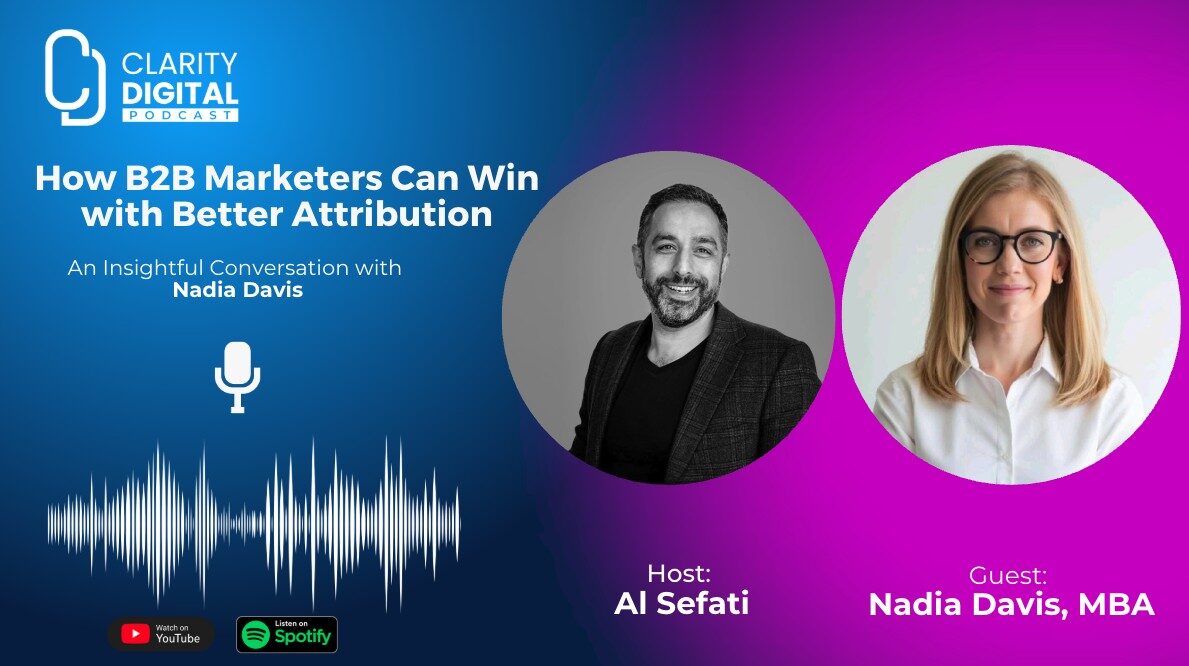From Data Chaos to Clarity: How B2B Marketers Can Win with Better Attribution – A Conversation with Nadia Davis
In today’s B2B landscape, marketing leaders are under pressure like never before. It’s no longer enough to run great campaigns — CMOs and marketing VPs are being asked to prove ROI, connect every dollar spent to revenue, and justify their team’s existence to sales and finance. The problem? Most companies are swimming in data, but starved for insight.
In this episode of the Clarity Digital Pod, host Al Sefati is joined by Nadia Davis, VP of Marketing at CaliberMind, a leading multi-touch attribution and go-to-market intelligence platform. Together, they unpack the core challenges that B2B marketers face with fragmented data, misaligned KPIs, and the ongoing battle to gain trust from revenue stakeholders.
Episode Summary and Takeaways
Why Data Chaos Still Plagues B2B Marketing Teams
Despite the explosion of martech tools promising quick insights, most B2B teams still face the same issue: data silos and disconnected platforms.
- Marketing has one version of the truth in HubSpot.
- Sales lives in Salesforce.
- Leadership looks at Google Analytics or dashboards pulled together in spreadsheets.
According to Davis, this fragmented view leads to “analytics that start debates, not decisions.”
She highlights how the excitement over dashboards often masks the real issue — poor data integrity and inconsistent measurement standards. Without a shared framework for what counts as a qualified lead, meaningful engagement, or a successful campaign, teams waste time debating metrics rather than acting on them.
The Rising Demand for Multi-Touch Attribution in B2B
Attribution isn’t a new concept, but it’s more urgent than ever. In B2B, the buyer’s journey is long, complex, and spread across multiple platforms — from social touches on LinkedIn, to emails, website visits, webinars, and personal outreach by sales.
Traditional last-click attribution simply doesn’t work anymore. As Davis puts it:
“If you rely only on last-click, you’d probably stop doing social media altogether. But in B2B, those early touches matter more than you realize.”
Multi-touch attribution (MTA) provides a more accurate picture of the full buyer journey, showing which channels, content, and campaigns are contributing to pipeline — not just conversions.
At CaliberMind, the emphasis is on building a “single source of truth” that can unify marketing and sales data in one place, enabling teams to act on clean, trustworthy insights.
From Power User to VP: Why Nadia Davis Believes in Data-Driven Marketing
Davis’s perspective comes not only from leading marketing at CaliberMind, but also from being a former client. As a previous power user of the platform, she experienced firsthand the pain of last-minute reporting requests and siloed systems.
“Every Friday at 4 PM, I’d get a request from leadership: ‘Can you pull this report?’ That used to ruin my weekend. Now with clean attribution and shared dashboards, those fire drills are gone.”
This real-world experience fuels her passion for building marketing systems that scale — not just operationally, but politically. When data is trusted, it earns marketing a seat at the strategy table, rather than just being a cost center to explain.
Marketing KPIs vs Sales KPIs: Why Alignment Is Still Broken
One of the central themes in the conversation is the misalignment between marketing and sales. Despite years of talking about “smarketing” and lead scoring, many companies still struggle with translating marketing engagement into sales action.
- Marketing focuses on engagement, brand awareness, MQLs.
- Sales cares about opportunities, pipeline, and closed revenue.
Without a shared understanding of what an MQL really means — and how it should be acted on — trust breaks down.
As Nadia explains:
“MQLs became the scapegoat. Everyone blames them, but few companies actually define them properly. You need sales and marketing to sit down and agree on exactly what qualifies a lead — and then operationalize it.”
She advocates for clear definitions, shared expectations, and systems that surface actionable insights — not just fluffy engagement scores.
The Role of CDPs and Data Warehouses in Modern Marketing Ops
Another key takeaway from the episode is the growing importance of customer data platforms (CDPs) and marketing data warehouses.
According to Davis, more marketing tech stacks are merging traditional CRM functions with CDP capabilities to centralize data and streamline attribution. This is essential in a world where buyer journeys span dozens of touchpoints across multiple tools.
“At CaliberMind, we sit on a data warehouse. That’s what allows us to pull in structured and unstructured data — clean it, dedupe it, and align it around the buyer journey. Only then can you trust what you see.”
This kind of architecture also supports generative AI tools that summarize large engagement histories and provide sales teams with actionable next steps — without drowning in dashboards or log files.
The Human Side of Attribution: Giving Marketers Their Time Back
While the tech is important, Davis also emphasizes the human cost of bad reporting.
When marketers spend hours each week pulling reports, validating numbers, and reconciling spreadsheets, it eats into their ability to do creative, strategic work. Attribution tools like CaliberMind aren’t just for leadership visibility — they’re for freeing up the team.
“You can’t be creative if you’re constantly debugging spreadsheets. You can’t focus on strategy if you’re busy defending your data.”
The ABM Reporting Gap: What Most Platforms Miss
Account-based marketing (ABM) platforms like RollWorks or AdRoll often provide their own dashboards, but Davis warns that these can be misleading.
- Many ABM tools show fractional views — focusing only on digital engagement.
- They often don’t incorporate offline touchpoints, sales interactions, or CRM nuances.
- And few offer full buyer journey visibility across the organization.
She recommends using ABM dashboards for directional insight, but always marrying that with centralized attribution data from your CRM or a dedicated platform like CaliberMind.
Vanity Metrics vs Strategic Signals: Where the Line Really Is
Davis also tackles the much-maligned topic of “vanity metrics.”
Yes, impressions, likes, and clicks can be distracting — but that doesn’t make them useless.
“Vanity metrics are only a problem when they’re treated as outcomes. But as signals? They’re valuable. Sometimes they tell you where to look deeper.”
The key is to embed them into a larger attribution model where engagement leads to insight — not just a slide in the QBR deck.
The Future of B2B Attribution: Generative AI and Intent Insights
Looking ahead, Davis sees generative AI playing a growing role in marketing intelligence. With tools that can summarize hundreds of engagement data points into a digestible snapshot, marketers and sellers alike can make faster decisions — especially in enterprise sales cycles.
In combination with structured attribution, these tools can:
- Identify which accounts are heating up
- Summarize engagement timelines
- Highlight the most active stakeholders
- Recommend next best actions for sales outreach
This evolution means marketers can finally get back to what they’re best at — driving strategy, creativity, and pipeline — not just generating reports.
Final Thoughts: Clarity Beats Complexity
This episode with Nadia Davis underscores a truth that many B2B marketers understand instinctively but often struggle to implement:
More data isn’t better — better data is better.
Effective attribution isn’t just a reporting tool — it’s a shared language. It brings clarity across marketing, sales, and leadership. It builds trust. It connects strategy to execution.
And as Nadia put it:
“If you want to run fast, run alone. If you want to run far, run together.”
That’s the essence of marketing and sales alignment.
Closing: B2B Marketing is About Being Creative & Credible
This conversation offers a roadmap for any B2B marketing leader facing data overload, KPI confusion, or fractured internal alignment. Whether you’re leading marketing at a high-growth startup or steering enterprise teams through complex tech stacks, the takeaways are the same:
- Define and align on what qualifies a lead
- Centralize and clean your data before building strategy around it
- Move away from vanity metrics as outcomes — use them as signals
- Implement multi-touch attribution to capture the real buyer journey
- Replace reactive reporting with strategic, insight-driven conversations
B2B marketing is no longer about just being creative — it’s about being credible.
Need Help Building a Better Attribution Strategy?
Clarity Digital Agency works with B2B and SaaS companies to solve the very attribution and data integrity challenges discussed in this episode. From go-to-market strategy and analytics audits to execution and training, we help teams build clarity into their systems and decision-making.
Contact Clarity Digital to start building a smarter marketing operation designed to convert data into revenue.





